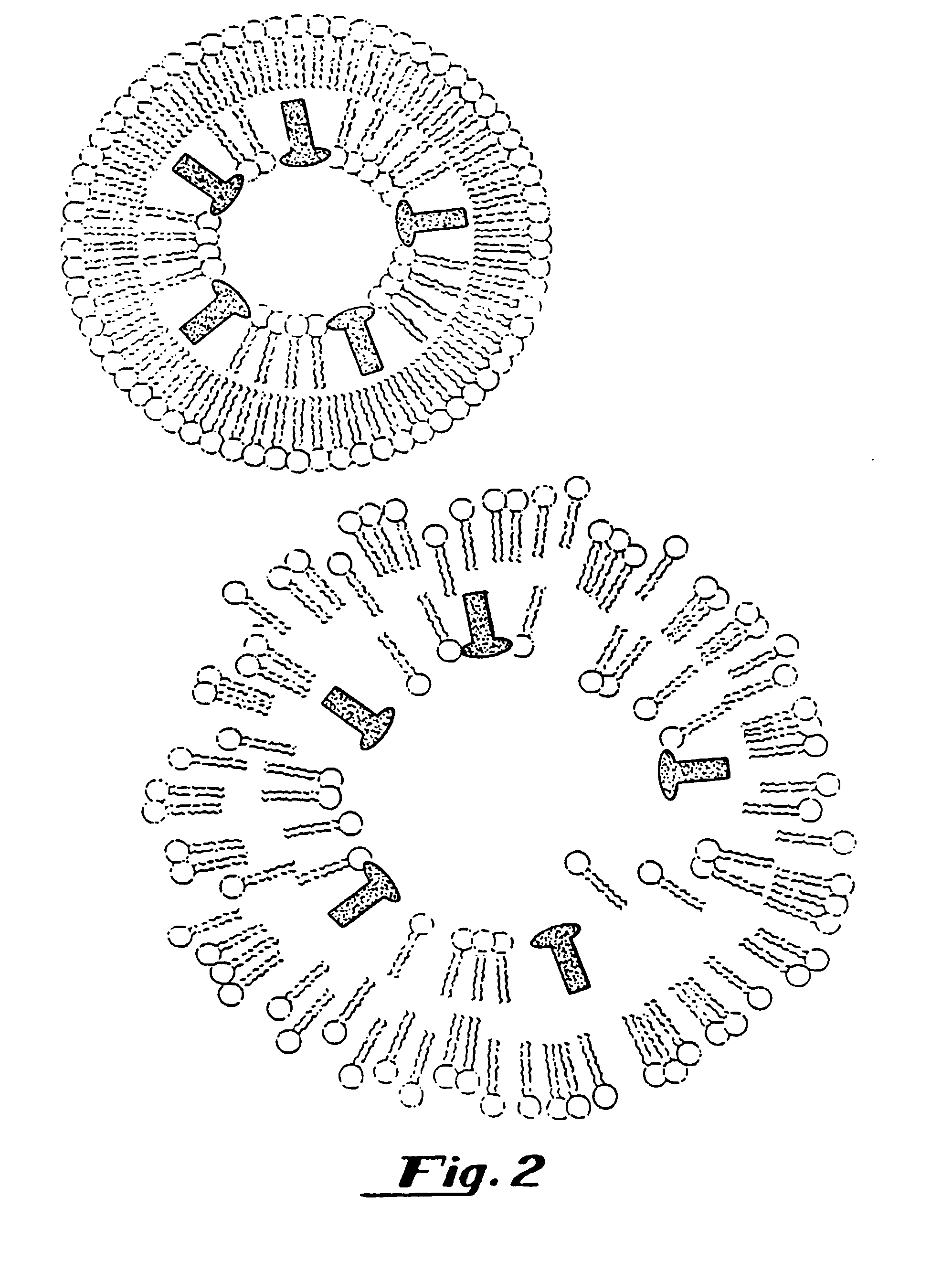Therapeutic delivery systems
a technology of therapeutic compound and delivery system, which is applied in the field of therapeutic compound delivery system, can solve the problems of x-rays, which are known to be somewhat dangerous, prohibit portable examination, and large shear size, and achieve the effect of enhancing cellular uptake of therapeutic compound and increasing membrane fluidity
- Summary
- Abstract
- Description
- Claims
- Application Information
AI Technical Summary
Benefits of technology
Problems solved by technology
Method used
Image
Examples
example 1
[0291]The methods described below demonstrate that a therapeutic such as DNA can be entrapped in gas-filled microspheres and that ultrasound can be used to release a therapeutic from a gas-filled microsphere. As shown below, liposomes entrapping water and DNA failed to release the genetic material after exposure to the same amount of ultrasonic energy. The presence of the gas within the microspheres results in much more efficient capture of the ultrasonic energy so it can be utilized for delivery of a therapeutic such as genetic material.
[0292]Gas-filled liposomes were synthesized as follows: Pure dipalmitoylphosphatidylcholine (DPPC), Avanti Polar Lipids, Alabaster, Ala., was suspended in normal saline and then Extruded five times through 2 micron polycarbonate filters (Nuclepore, Costar, Pleasanton, Calif.) using an Extruder Device (Lipex Biomembranes, Vancouver, Canada) at 800 p.s.i. The resulting liposomes were then dried under reduced pressure as described in U.S. Ser. No. 716,...
example 2
[0312]Binding of DNA by liposomes containing phosphatidic acid and gaseous precursor and gas containing liposomes. A 7 mM solution of distearoyl-sn-glycerophospate (DSPA) (Avanti Polar Lipids, Alabaster, Ala.) was suspended in normal saline and vortexed at 50° C. The material was allowed to cool to room temperature. 40 micrograms of pBR322 plasmid DNA (International Biotechnologies Inc., New Haven, Conn.) was added to the lipid solution and shaken gently. The solution was centrifuged for 10 minutes in a Beckman TJ-6 Centrifuge (Beckman, Fullerton, Calif.). The supernatant and the precipitate were assayed for DNA content using a Hoefer TKO-100 DNA Fluorometer (Hoefer, San Francisco, Calif.). This method only detects double stranded DNA as it uses an intercalating dye, Hoechst 33258 which is DNA specific. It was found that the negatively charged liposomes prepared with phosphatidic acid surprisingly bound the DNA. The above was repeated using neutral liposomes composed of DPPC as a co...
example 3
[0313]A cationic lipid, such as DOTMA is mixed as a 1:3 molar ratio with DPPC. The mixed material is dissolved in chloroform and the chloroform is removed by rotary evaporation. Water is added to the dried material and this mixture is then extruded through a 2 μm filter using an Extruder Device (Lipex Biomembranes, Inc., Vancouver, BC). Then positively charged gaseous precursor-filled liposomes are prepared according to the procedure provided in U.S. Ser. No. 717,084, filed Jun. 18, 1991, which is hereby incorporated by reference in its entirety.
[0314]The resulting dried, positively charged gaseous precursor-filled liposomes are rehydrated by adding PBS, saline or other appropriate buffered solution (such as HEPES buffer); a vortexer may be used to insure homogenous mixing. DNA is added and the mixture is again shaken. Since the DNA is attached to the surface of the cationic gaseous precursor-filled liposomes, unattached DNA may be removed with filtering or selective chromatography....
PUM
 Login to View More
Login to View More Abstract
Description
Claims
Application Information
 Login to View More
Login to View More - R&D
- Intellectual Property
- Life Sciences
- Materials
- Tech Scout
- Unparalleled Data Quality
- Higher Quality Content
- 60% Fewer Hallucinations
Browse by: Latest US Patents, China's latest patents, Technical Efficacy Thesaurus, Application Domain, Technology Topic, Popular Technical Reports.
© 2025 PatSnap. All rights reserved.Legal|Privacy policy|Modern Slavery Act Transparency Statement|Sitemap|About US| Contact US: help@patsnap.com



